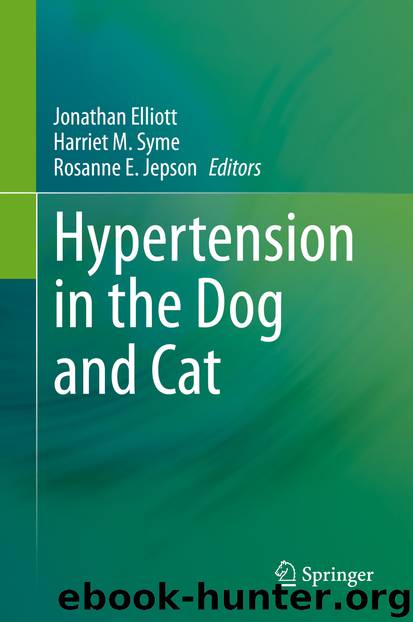Hypertension in the Dog and Cat by Jonathan Elliott & Harriet M. Syme & Rosanne E. Jepson

Author:Jonathan Elliott & Harriet M. Syme & Rosanne E. Jepson
Language: eng
Format: epub
ISBN: 9783030330200
Publisher: Springer International Publishing
(2)Department of Physiology and Pharmacology, University of Georgia College of Veterinary Medicine, Athens, GA, USA
Amanda E. Coleman (Corresponding author)
Email: [email protected]
Scott A. Brown
Email: [email protected]
8.1 Introduction
The importance of the heart as a target for end-organ damage in hypertensive disease has long been recognized. The earliest scientific reports detailing myocardial hypertrophy in human patients with renal disease and changes to the “minute arteries of the body” appear in the medical literature of the nineteenth century (Bright 1836; Gull and Sutton 1872). As early as 1913, soon after the ability to non-invasively measure blood pressure and to associate the results of these measurements with pathological outcomes was facilitated by the description of Korotkoff sounds and the sphygmomanometric technique, investigators were able to link elevated blood pressure measurements with clinical signs of left ventricular hypertrophy and cardiac death (Janeway 1913). Approximately 50 years later, in the 1960s, clinical descriptions of cardiac involvement in dogs with naturally occurring systemic arterial hypertension appeared in the veterinary literature (Pirie et al. 1965; Anderson 1968; Anderson and Fisher 1968).
For human patients, systemic arterial hypertension represents a major risk factor for cardiovascular disease and its various manifestations. Compared to normotensives, hypertensive people are at increased risk for all-cause and cardiovascular disease mortality, coronary artery disease, myocardial infarction, heart failure, atrial fibrillation, stroke and transient ischaemic attack and peripheral vascular disease, with increasing age acting as a major modifier of this effect (Bakris and Sorrentino 2018). Hypertensive people have a two- to threefold greater relative risk for cardiovascular events compared to age-matched normotensives, and even mild increases in systolic blood pressure beyond normal are associated with increased risk (Lewington et al. 2002; Stamler et al. 1993).
Most descriptions of the effects of systemic hypertension on the heart are based upon data generated in experimental (e.g. aortic banding, renal-wrap, genetic) animal models and in spontaneous human disease, none of which faithfully replicate the clinical disease of dogs and cats. The majority of human hypertensives are affected by primary (“essential”) hypertension, a heterogeneous condition that is influenced by complex interactions among cardiac, vascular, renal, neurologic and endocrine processes, as well as environmental, genetic and behavioural factors (Bakris and Sorrentino 2018). Furthermore, human hypertension infrequently develops in isolation, instead coexisting with conditions that are also known to be independent risk factors for cardiovascular disease. While the essential hypertension of human beings should be regarded as a pathophysiologic entity that is distinct to the idiopathic or secondary hypertension of companion animals, there remain lessons to be learned from the large amount of information generated by study of these patients.
This chapter describes the structural and functional cardiac and vascular alterations noted with sustained, pathological increases in systemic arterial blood pressure. The clinical relevance of these alterations is considered.
Download
This site does not store any files on its server. We only index and link to content provided by other sites. Please contact the content providers to delete copyright contents if any and email us, we'll remove relevant links or contents immediately.
| Administration & Medicine Economics | Allied Health Professions |
| Basic Sciences | Dentistry |
| History | Medical Informatics |
| Medicine | Nursing |
| Pharmacology | Psychology |
| Research | Veterinary Medicine |
Tuesdays with Morrie by Mitch Albom(4690)
Yoga Anatomy by Kaminoff Leslie(4305)
Science and Development of Muscle Hypertrophy by Brad Schoenfeld(4088)
Bodyweight Strength Training: 12 Weeks to Build Muscle and Burn Fat by Jay Cardiello(3913)
Introduction to Kinesiology by Shirl J. Hoffman(3725)
How Music Works by David Byrne(3187)
Sapiens and Homo Deus by Yuval Noah Harari(2987)
The Plant Paradox by Dr. Steven R. Gundry M.D(2547)
Churchill by Paul Johnson(2506)
Insomniac City by Bill Hayes(2496)
Coroner's Journal by Louis Cataldie(2432)
Hashimoto's Protocol by Izabella Wentz PharmD(2331)
The Chimp Paradox by Peters Dr Steve(2297)
The Universe Inside You by Brian Clegg(2097)
Don't Look Behind You by Lois Duncan(2079)
The Immune System Recovery Plan by Susan Blum(2027)
The Hot Zone by Richard Preston(1983)
Endure by Alex Hutchinson(1964)
Woman: An Intimate Geography by Natalie Angier(1882)
